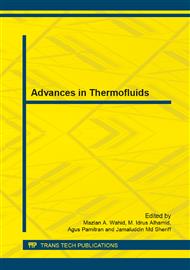p.83
p.91
p.96
p.101
p.106
p.111
p.116
p.123
p.128
A Study on the Effect of Exhaust Gases on the Indoor Air Quality Onboard Ships
Abstract:
The understanding of the exhaust gas behaviour from ship plume is necessary in order to avoid serious operational problems onboard modern naval ships. The interference of exhaust gas on the air intake for ventilation system can result in poor indoor air quality (IAQ) and can adversely affect the performance of human and equipment onboard ships. This paper presents the results of an indoor air quality study carried out onboard a naval ship and focuses on parameters such as temperature, humidity and major air pollutants. An analysis of the velocity ratio K which represents the ratio of exhaust velocity to relative wind velocity will also be presented to demonstrate the effect of the velocity ratio K on the indoor air quality for three locations of the air intake for the ventilation system and two different conditions of the ship namely alongside and cruising at an economical speed
Info:
Periodical:
Pages:
106-110
Citation:
Online since:
August 2013
Authors:
Keywords:
Price:
Сopyright:
© 2013 Trans Tech Publications Ltd. All Rights Reserved
Share:
Citation:


